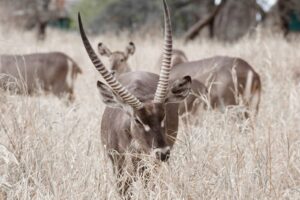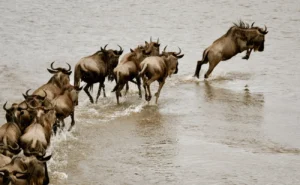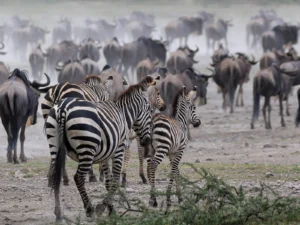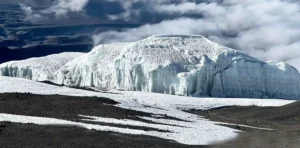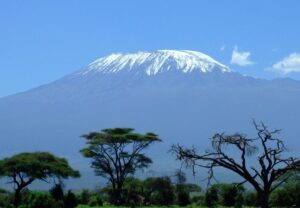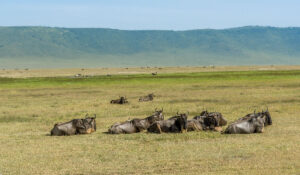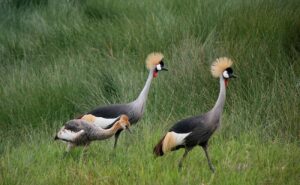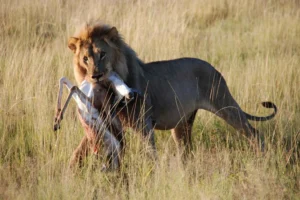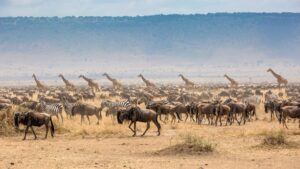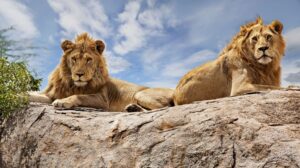Table of Contents
The Wildebeest Migration Serengeti: The Greatest Wildlife Wonder
The Wildebeest Migration Serengeti, or the Great Migration, is one of the most spectacular displays of nature. Over 1.5 million wildebeest, zebras, gazelles, and impalas make this grand migration each year, migrating from Tanzania to Kenya to feed on the new pastures. This spectacular migration follows a year-round pattern depending on rainfalls, with spectacular displays ranging from the southern Serengeti during the calving months of December to April, to crossing the river Grumeti in April-May, and to reaching the green pastures of the Masai Mara from July to October.
Watching the Wildebeest Migration Serengeti is a must for nature lovers, with unmatched opportunities to view new-born calves, predators, and spectacular river crossings. Luxury safari lodges complement the Wildebeest Migration Serengeti with comfort as well as with great vistas, and specialty activities such as hot-air balloon safari give distinct vantage views of this wonder of nature.
Organizing your tour with safari specialists guarantees that you experience the prime activities of the Wildebeest Migration Serengeti, ranging from the calving to the spectacular crossings that are the hallmarks of this unforgettable experience.
Overview of the Great Wildebeest Migration

The Great Wildebeest Migration is a spectacular natural wonder that attracts over 1.5 million wildebeest, along with hundreds of thousands of gazelles and zebras, as they trek each year between the Serengeti in Tanzania and the Maasai Mara in Kenya. The migration is the result of the wildebeest chasing the seasonal rainfalls and the new grazing areas, along a generally 1,800-mile seasonal pattern. As a result of the gigantic scale as well as the spectacular wildlife experiences that it offers, the migration has always been referred to as ‘The Greatest Show on Earth’ as it features in the list of the Seven Natural Wonders of Africa.
The Wildebeest Migration Serengeti plays a crucial role in the Serengeti-Mara ecosystem health. As the wildebeest and their fellow travelers migrate, they facilitate nutrient cycling as well as biodiversity enhancement. The predators like lions, crocodiles, and hyenas are hot on the heels of the herds, making thrilling as well as quite risky encounters, primarily during river crossings where numerous wildebeest succumb to the hazardous waters as well as the waiting predators.
The Wildebeest Migration Serengeti provides one of the most spectacular wildlife displays on the planet. This is a live show where survival instincts are seen in the raw act of nature, always thrilling nature lovers as well as professionals with a passion for photography.
The dates and the actual pattern of the Wildebeest Migration Serengeti can be different from year to year with the change in the climatic conditions, thereby rendering each migration distinct. The migration also possesses ultimate cultural significance to the Maasai people within the Kenya and Tanzania regions where the migrants reside, as this has coexisted with the migration pattern over the centuries.
In order to be able to enjoy the Wildebeest Migration Serengeti to the fullest, adventurers are encouraged to plan their tour during the prime migration activities, i.e., the calving or the great river crossings. Local guides alongside safari experts assist to provide useful information as wells as access to the best view sites along the migration corridor.
When to Go & Where to See the Migration
The Wildebeest Migration Serengeti is a seasonal event that happens throughout the year with various components of the migration occurring during various seasons. During the months of December to March, the herds gather at the southern plains of the Wildebeest Migration Serengeti during the calving. The fresh grazing readily available facilitates the best condition required to nourish the newly born calves.
When the rain starts in April, the Wildebeest Migration Serengeti migration heads to the central plains. This progression lasts until May, as the herds continue to move north gradually. The herds reach the western corridor of the Wildebeest Migration Serengeti in June, prior to the rugged crossing of the Grumeti River.
The best time to witness the spectacular crossings of the Wildebeest Migration Serengeti is between the months of July to August. During this season, thousands of wildebeest will try to cross the Mara River into Kenya’s Maasai Mara to present one of nature’s most spectacular displays.
In September to October, the Serengeti Wildebeest Migration hits a quiet period of the year as the herds spread out throughout the Maasai Mara to feed on the lush grass. This gives travelers great opportunities to spot wildlife in a quieter, laid-back atmosphere.
In November, the wildebeest start their migration back to the Serengeti, beginning the last step of the Wildebeest Migration Serengeti circle. The dates of each step can differ each year based on the rainfalls and the foods that are present. In order to fully enjoy the extent and grandeur of the Wildebeest Migration Serengeti, hot air balloon safari provides a bird’s eye view. As a more exclusive experience, tourists can view the Wildebeest Migration Serengeti from private conservancies around the Maasai Mara that are free of crowds.
Organizing a safari based on the Wildebeest Migration Serengeti guarantees that you will see one of the most spectacular phenomena of nature in all raw power and beauty.
Monthly Migration Trends
January – The Serengeti Wildebeest Migration springs to life as the calving takes place in the southern plains. Thousands of calves are born every day, contributing a crucial injection to the wildebeest numbers as well as giving a big show to the crowds. This is the most important time as this lays the foundation for the rest of the migration pattern.
February – Continues the calving months. However, with the new births coming in such numbers, predators like lions and hyenas prey on the numbers of exposed calves. It’s a season of growth as well as danger for the herds.
March – The southern grasslands dry up, causing the herds to migrate northwards to find new grazing areas. This marks the start of their long migration within the Serengeti Wildebeest Migration.
April – The migration moves to the central Serengeti. The herds here are less dense, utilizing the new grass that has emerged in the area. This section of the Wildebeest Migration Serengeti is defined as one of unending motion with grazing.
May – The herds converge in the Serengeti centre to start the long migration to the west corridor. This is the most important time of preparation as the wildebeest stock up to tackle the challenges that lie ahead.
June – One of the best months of the migration, as the herds arrive along the banks of the Grumeti River. River crossings are perilous since huge crocodiles lie in ambush. They are some of the most dangerous and spectacular events in the Wildebeest Migration Serengeti.
July – The herds are in the northern Serengeti and start the risky crossings of the Mara River into Kenya. This phase is highly risky and one of the most highlighted events among wildlife enthusiasts.
August – Big herds of wildebeest and also of zebras are present in the Maasai Mara. This is a wonderful time to watch as the herds fan out over the plains in search of the rich grazing.
September – The herds continue to range across the Maasai Mara making the most of the fertile grazing. The time remains one of comparative stability as the herds graze as they prepare to journey back to the south.
October – The Serengeti Wildebeest Migration starts the migration towards the south with the onset of the rainy season. This migration finishes the migration cycle yet one more time, completing the seasonal migration pattern.
January – Calving season starts in the south Serengeti; thousands of calves give birth every day.
February – Calving continues as predators take advantage of plentiful opportunities among young susceptible to attacks.
March – The northern herds begin to move as the southern plains dry.
April – The migration advances towards the inner Serengeti, with stragglers grazing on fresh grass.
May – The herds converge around the Serengeti’s central region, in anticipation of the migration to the western corridor.
June – The migration arrives at the Grumeti River, with the risky crossings drawing big crocodiles.
July – The migrations move to the northern Serengeti and start crossing the Mara River to Kenya. Great wildebeest and zebra migrations can be observed in the Maasai Mara, with spectacular sightings.
September – The Maasai Mara herds graze across the wide expanses, taking advantage of abundant grazing.
October – The migration continues the southward journey back to the Serengeti as the wet season arrives.
Safari Tour
The most common method of viewing the migration is taking a game drive. Visitors can go on morning and afternoon safari, giving them the best possible chance of viewing the activities. Game drives are led by knowledgeable rangers who will take the best positions to view the herds.
For the ultimate safari, guided walking safaris allow one to experience the wildlife intimately on foot. This is a different perspective as well as a different relationship with the environment. Safely accompanied by experts, the walks are educational as well.
Evening drives allow one the chance to observe night dwellers and predator behaviors that usually go unnoticed during the day. Observing a lioness on the hunt or a hyena scavenging can be a most unforgettable experience.
The balloon safari will give you a bird’s-eye view of the large herds as well as the terrain beneath. Trundling silently over the Serengeti at dawn can be a sublime beginning to the day.
The camping mobile safaris track the migration, so the clients are always right in the midst of things. The camps are comfortable, with the chance to be near the wilds.
Cultural tours to Maasai villages also present one with the chance to live with the indigenous people. The visitor can learn the Maasai culture, their interaction with the environment, as well as their conservation efforts.
Riverboat safaris along the Grumeti River give a different view of the river crossings, a big feature of the migration. Viewing wildebeest boldly crossing the river in the company of crocodiles is a spectacular view.
The photographic safaris are customized for photographers with guides emphasizing the best angle and lighting. As a professional or a novice, the offered safaris enable you to take the best pictures of the wildlife as well as the terrain.
Serengeti high-end lodges and camps set up with luxurious facilities in the midst of the wild give you ultimate comfort at the end of a day of activities.
Bush breakfasts and bush dinners give you the best dining experience in the midst of nature. Think of having a meal with the open skies above and the sounds of nature all around. What better way to cap off a day of exploration?
The most common way of experiencing the migration is with the utilization of the game drives, morning and afternoon excursions that track the migration route of the herds.
Your walking safari guides will give you the ultimate experience since you will be within close range to the wildlife walking with professional guides educating you about the ecosystem.
Night drives reveal nocturnal creatures and predator activities that are often missed during the day, adding another layer to your safari adventure.
The hot-air balloon safari provides a bird’s-eye view over the big herds and magnificent Serengeti scenery below—a spine-tingling experience of the migration.
The mobile camping safaris track the migration, putting you right in the midst of the action with the most spectacular wildlife viewing opportunities.
Cultural excursions to Maasai communities provide one with a glimpse of the customs as well as the day-to-day activities of native individuals who live alongside wildlife over generations.
Grumeti River boat safaris offer a different perspective during the river crossing, typically with spectacular predator-prey encounters.
Photographic safaris are specifically crafted with the photographer in mind, with professional guides that ensure the ideal photo occurs with ideal conditions of lighting and angle.
Tented camps and luxury lodges couple top-flight amenities with ideal spots, treating you to comfort and breathtaking vistas in the heart of the bush.
Bush breakfasts and bush dinners present a one-of-a-kind dining experience, with the opportunity to enjoy gourmet meals amongst sounds and aromas of the bush.
Top Safari Lodges to Watch Migration Viewing
Serengeti Under Canvas – For front-row seats to the grand wildebeest migration. The camps transfer with the migration so no matter where it is headed, you will be front-row center.
Singita Mara River Tented Camp – Located north of the Serengeti, ideal to witness the magnificent river crossings.
Rekero Camp, Maasai Mara – Offers ideal viewing sites overlooking the Mara River crossings for live migration viewing.
Kleins Camp – Situated in a private concession overlapping the Serengeti, ensures private, uncrowded wildlife watching.
Governors’ Camp – One of the oldest camps in the Maasai Mara, with front-row seats to the migration and long-standing credibility.
Lamai Serengeti – Sits atop a kopje with commanding views over northern Serengeti plains, ideal for migration action.
Mara Plains Camp – Luxurious camp offering a private wildlife experience with the migration up close.
Serian’s Serengeti Mobile – Tracks the migration year-round, offering guests a dynamic, hands-on safari experience.
Sayari Camp – Set in the northern Serengeti for ultimate Mara River crossing views.
Elewana Sand River – Located along the Sand River in Maasai Mara, the best location to witness the migration quietly.
Special Experiences
Perhaps the most spectacular Serengeti migration experience is watching a crossing over the Mara River. The sheer drama of thousands of wildebeest streaming into the river with powerful currents to navigate, along with crocodiles waiting to ambush them, is nothing less than spectacular.
During the southern Serengeti calving season, thousands of wildebeest calves are born within a few weeks. This is both the season of new beginnings and the time of vulnerability and strength as the young take their first steps.
For the adventurous, hot air balloon safaris provide a spectacular bird’s-eye view of the migration. Soaring above the herds in silence, visitors can take wide-angle pictures and absorb the grandeur of the Serengeti as never before.
Experiencing the migration on foot with seasoned guides allows one to immerse fully in the environment. Feeling the ground beneath your feet and observing wildlife up close offers a close relationship with nature.
Night drives present a chance to observe nocturnal wildlife and predator-prey dynamics under the cover of darkness. With expert guides, you can witness the Serengeti’s nightlife, including lions on the hunt and other elusive creatures.
Photo safaris are customized to achieve the ultimate migration photograph. Guided by professionals, visitors can capture the best images of this natural phenomenon.
Mobile camping presents the ultimate experience by following the herds, ensuring you are always near the action and gaining a true experiential migration experience.
Visiting the local Maasai people adds a cultural dimension. Learning about their customs and daily life alongside wildlife makes the safari more rewarding.
Riverboat safaris along the Grumeti River during migration crossings provide a unique perspective. Viewing wildebeest cross rivers in the comfort of a riverboat adds an exciting twist.
Private conservancies deliver a quieter and more individualized migration experience. These private reserves allow visitors to enjoy the spectacle away from the crowds, offering a calm and intimate experience.
Planning Your Trip
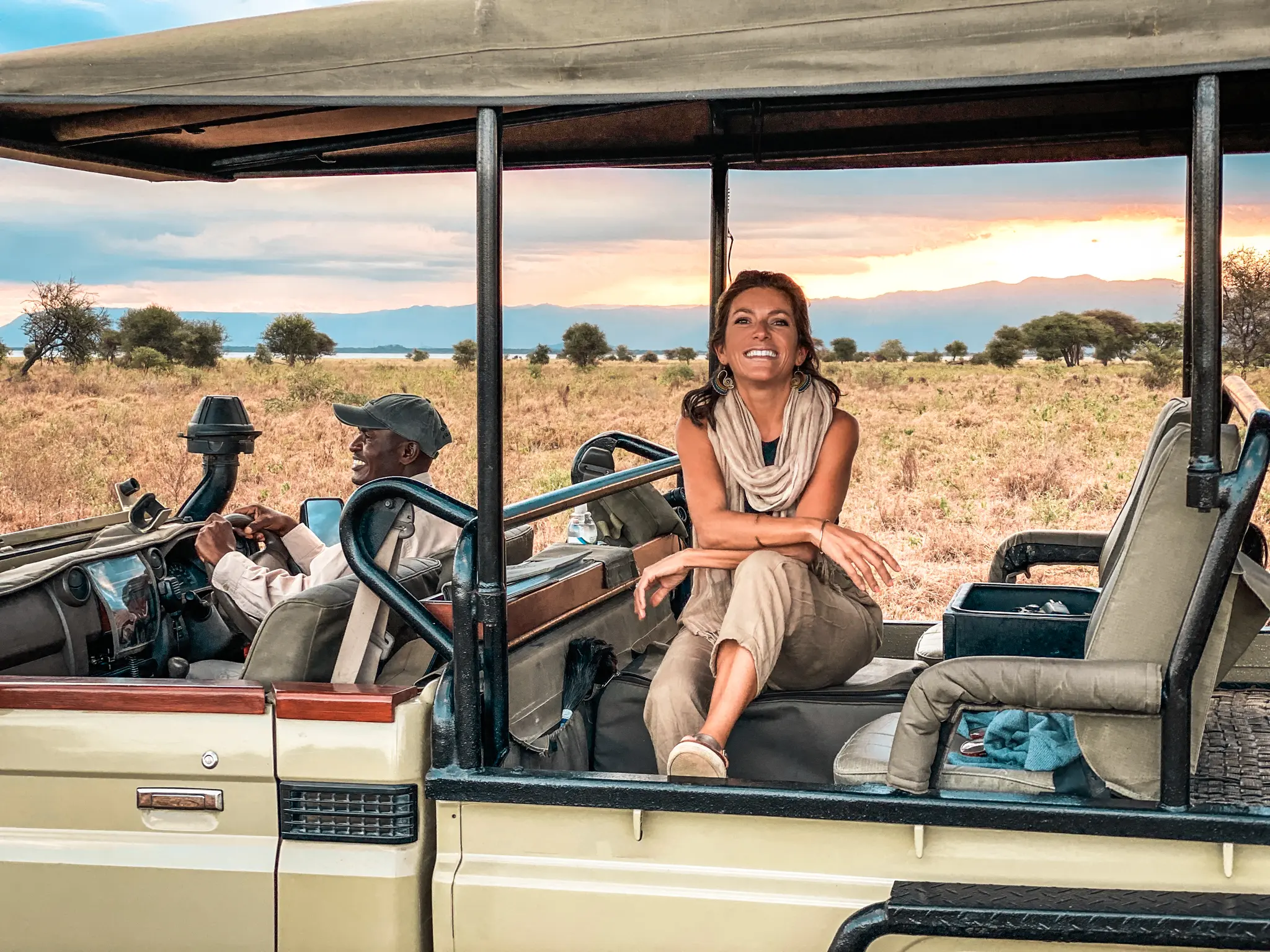
The best time to go to the Serengeti largely depends on what part of the wildebeest migration you’d be interested in watching. The grand river crossings, for instance, take place during the months of July to August; these months are extremely busy as a consequence. Advanced booking will be highly advised if you will pursue this busiest time.
You can also opt to look into combination safaris that cover both the Maasai Mara in Kenya and the Serengeti in Tanzania. This will allow you to see different stages of the migration as well as increase your chances of watching spectacular wildlife activity.
Your accommodations can make or break your migration watching experiences. If you desire to stay with moving camps that move with the herds or live-in lodges with prime viewing positions, ensure to stay long enough to achieve your safari targets.
Proper clothing is key, as the climate can be quite varied. Layer clothing to be prepared for the chillier evenings and be ready with rain gear. Consult with safari experts to personalize your schedule, aligning your best possibilities for wildlife opportunities.
Don’t forget to check visa requirements for both Tanzania and Kenya, and make sure your passport is valid for at least six months beyond your travel dates, especially if you plan to witness the Wildebeest Migration Serengeti. Necessary vaccinations and travel insurance are also important considerations for a smooth Wildebeest Migration Serengeti trip.
Grasping the travel logistics within the area will help you derive the most benefit out of the Wildebeest Migration Serengeti experience. This covers internal flights as well as transfers between lodges around the best migration viewing spots. Lastly, be mindful of the local etiquette as well as wildlife etiquette to achieve a responsible yet enjoyable Wildebeest Migration Serengeti safari that lets you bask in this unmissbable natural wonder.
Typically Raised Points / Doubts
1. At what time of the year wildebeest migrate during Serengeti?
The wildebeest generally graze between June and August. They migrate to find new grass and drinking water.
2. How many wildebeest are there in the migration?
Approximately 1.5 million wildebeest take part in the migration, rendering it one of the largest animal migrations the world has ever seen.
3. Why wildebeest migration happens in Serengeti
The wildebeest move in search of green pastures and water. They are moved by the availability of grazing and the seasonal rain.
4. What other animals join the wildebeest during migration?
The gazelles and the zebras will generally migrate with the wildebeest. The lions and crocodiles usually follow the migration to hunt too.
5. Where do wildebeests go during migration?
The wildebeest migrates between the Serengeti in Tanzania to the Maasai Mara in Kenya and vice versa, crossing approximately 1,000 kilometers.
See the Great Wildebeest Migration, a seasonal migration of about 1.5 million wildebeest between Kenya’s Maasai Mara and the Serengeti in Tanzania. This is among the best wildlife spectaculars globally.
Aided by the seasonal rains and the quest to find new grazing lands, the migration is a spectacular journey with exhilarating wildlife experiences. The predators like the lions, crocodiles, and hyenas give hot pursuit to the herds, creating indelible memories.
The Wildebeest Migration Serengeti is possible to view throughout the year, with months having varied phases and spots. This creates varied safari experiences based on what time of the year you visit the Wildebeest Migration Serengeti.
Guests can enjoy anything from conventional game drives, walking safaris, to hot air balloon rides—all with varied perspectives of the Wildebeest Migration Serengeti, capturing its grandeur from different angles.
To fully experience the Wildebeest Migration Serengeti, stay in some of the best lodges and mobile camps that are positioned to give the best view of the migration routes. Plan ahead with advance booking, selecting the right accommodations with reference to the season, as well as the right packing with reference to varied conditions to maximize your Wildebeest Migration Serengeti adventure.

